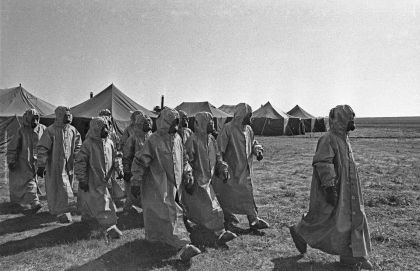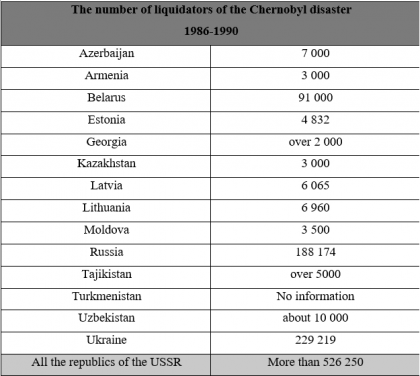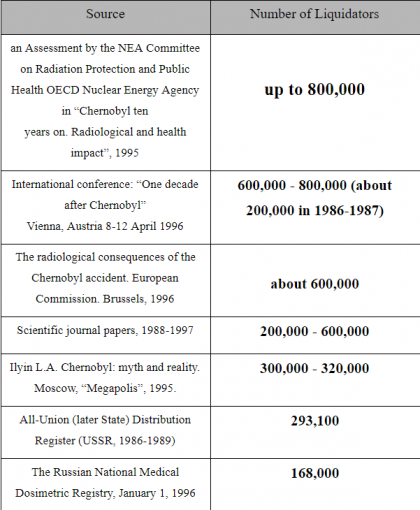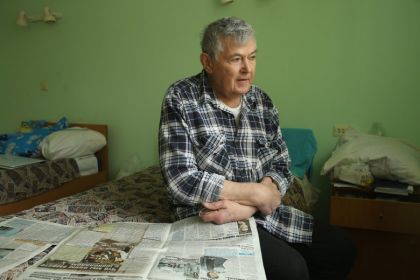The accident at the Chernobyl Nuclear Power Plant that happened more than thirty years ago was intertwined with the lives of many people. The clean-up operation following the Chernobyl accident was arguably the greatest in the history of mankind. While some fled, rescuing themselves from the radiation, others went to receive it. They were called liquidators – the world’s first line of defense against transcontinental radioactive contamination.
December 14 — Day in honoring of the Chernobyl accident consequences liquidation participants.
The date to honor the liquidators is chosen not without reason. On November 30, 1986, the sarcophagus construction over Unit 4 was completed. Two weeks later, on December 14, the main CPSU newspaper “Pravda” and other central publications of USSR published the Statement that the State Commission had been commissioned the complex of protective structures of ChNPP Unit 4. Namely the date of this statement publication became “Day of Chernobyl accident consequences liquidation participants honoring”.
Whether they did it voluntarily or under immense pressure, knowingly or in ignorance, the liquidators gave their lives and their health in order to limit the effects of the Chernobyl catastrophe. Through their commitment they were able to protect others from even worse harm.
The liquidators have earned our respect. Unfortunately, not only did they fall victim to fire, toxins, and radiation but also to an incompetent bureaucracy that has made it difficult, if not impossible, to establish the nature of their illnesses, to give them proper treatment and to support the liquidators either socially or financially.
Who are the Chernobyl Liquidators?

Servicemen of the Leningrad Military District participate in the liquidation of the Chernobyl accident, June 1, 1986.
Photo: ТАСС
There are a few different official definitions for “liquidator” in countries of the former USSR: Russia, Belarus, Ukraine, and the Baltic countries.
The word “liquidator” is now used to describe the civil and military personnel who were called upon to deal with the consequences of the 1986 Chernobyl nuclear disaster at the permanent eviction zone. This territory surrounds the Chernobyl station. It is not defined by a simple radius around the plant but by a pollution level, and represents an area from where the population was evacuated in 1986-1987.

Field camp of the rescue team of the Chernobyl disaster
Photo: UPPA/VOSTOCKPhoto
“Liquidate” means “to eliminate” or “to eliminate the consequences of an accident”.
It originates from the Soviet official definition “участник ликвидации последствий аварии на Чернобыльской АЭС” literally, “a participant in the liquidation of the Chernobyl NPP accident and its consequences”, which was widely used to describe the liquidators’ activities regarding their employment, healthcare and retirement. This exact phrase is engraved on the Soviet medals and badges awarded to the liquidators.

Soviet military badge (left) and medal awarded to liquidators
Source: Wikipedia
Soon after the explosion, it became clear that the consequences of the accident could not be “eliminated” but only “reduced” however the title was already in common use by this point.

The reservists at the Chernobyl Power Plant, who were gathered all over the country at the military registration and enlistment offices. They did the main dirty work. Some in respirators, some in gauze bandages.
Photo: Igor Gavrilov
People of various professions worked in the Exclusion Zone – firefighters, doctors, chemists, miners, builders, engineers, drivers, cooks, etc. They were described as workers involved in the clean-up including, emergency workers, accident recovery workers, salvage personnel or decontamination participants. Most of the liquidators were young men who served in the Soviet army and were in the reserve.
Liquidators can be divided into three groups: “early liquidators”, “liquidators 1986-1987” and “liquidators 1988-1991”.

Source: IAEA
During the initial phase, the “early liquidators” were on site during the explosion or arrived during the initial phase of the accident (0-1 days, before the evacuation of Pripyat), including fire fighters.
The early phase ranges from the end of the evacuation of Pripyat to the end of the construction of the sarcophagus (November 1986). Within this group are further subgroups including those who participated in clean-up works during 1986. Some of these workers, approximately 7% of all liquidators, received high doses (0.20-0.25 Gy).
The late phase liquidators worked between the end of the Sarcophagus construction until the dissolution of the USSR in 1991, when central management of the clean-up work was split between Russia, Belarus, and Ukraine. These people included power plants operators and emergency workers such as military personnel and firefighters, as well as many non-professionals.
The liquidator’s tasks included cleaning up the debris from around the reactor, construction of the sarcophagus, decontamination, road building, and destruction and burial of contaminated buildings, forests and equipment. Information on the danger involved was often unknown or suppressed.
The number of liquidators

This is the main entrance, the administrative building of the station, connected by galleries at the level of the second and third floors with all power units.
Photo: Igor Gavrilov
The number of liquidators involved varied greatly from several hundred thousand to nearly a million people. It is likely that at least 300,000 – 350,000 people were directly involved.
The International Conference “One Decade After Chernobyl” quotes a figure:
“An estimated 200,000 workers (known as “liquidators”), from the local police and fire services, the Army and volunteers, were initially involved in containing and cleaning up the accident in 1986 and 1987, either in the front lines or administratively. Later, the number of people who became registered as liquidators rose to between 600,000 and 800,000 although many listed received only low doses of radiation”.
Women consisted of less than 1% of the Chernobyl liquidators. They were mainly members of staff of the Chernobyl Nuclear Power Plant and medics participated in the clean-up work.

Source: The National Museum “Chernobyl” in Kyiv
About 600,000 persons (civilian and military) have received special certificates confirming their status as liquidators, according to laws promulgated in Belarus, the Russian Federation and Ukraine. Of those, about 240,000 were military servicemen.
“Somebody had to do it…” – Alexander Fedotov (liquidator).
Different organisations had presented their own research about Chernobyl accident:

The exact number of liquidators is still unknown since no clear records were kept and a single register of participants was compiled only a few years after the accident.
The role of a liquidator

The radioactive fallout that fell on the ground was turned over with the top layer of the soil, as if buried with a plow. The dosimetrists checked how much the background had decreased.
The principal tasks carried out by the recovery operation workers (liquidators) included the decontamination of the reactor block, reactor site, and roads (1986-1990), and the construction of the sarcophagus (May – November 1986), a settlement for reactor personnel (May – October 1986), the town of Slavutich (1986-1988, 1990), waste repositories(19861988), and dams and water filtration systems (July-September 1986, 1987). During the entire period, radiation monitoring and security operations were also carried out.
“Even we professionals didn’t know what to do after the explosion and could not understand its ramifications,” – Sergii Mirnyi a 27 year old chemist at the time of the disaster.
Chernobyl disaster management included thousands of occupations, positions and tasks:
- Personnel of the reactors
- Firefighters who immediately responded to the reactor accident
- Civil defense troops of the Soviet Armed Forces who intensively worked on the removal of contaminated materials and deactivation on the reactor itself and all affected territories
- Internal Troops and police who provided security, access control and population evacuation (at least 749 service persons of the Ukrainian SSR’s Ministry of Internal Affairs)
- Military and civil medical and sanitation personnel
- Groups of female janitors tasked with the cleanup of food left inside abandoned homes to prevent outbreaks of infectious disease
- Special hunting squads assigned to exterminate domestic animals left in evacuated settlements
- Soviet Air Force and civil aviation units who fulfilled critical helicopter-assisted operations on the reactor building, air transportation and aerial radioactive contamination monitoring
- Various civilian scientists, engineers, and workers involved in all stages of the disaster management
- Transportation workers
- A team of coal miners who built a large protective foundation to prevent radioactivity from entering the aquifer below the reactor.
- Construction professionals
- Media and performing arts professionals who risked their lives to document the disaster on the ground and provide on-site entertainment events for the liquidators
- Photographers: Igor Kostin and Volodymyr Shevchenko are credited with taking the most immediate and graphic pictures of the destroyed reactor and first months of the relief operation, including photos of liquidators conducting highly-hazardous manual tasks.
Extracts from Sergii Mirnyi’s – Reflections of a Chernobyl liquidator:
“More reinforcements were summoned. They lived in tent camps – some of which were several thousand men strong – that were located all over the 30-kilometer zone that surrounded the area affected by the exploded reactor. Each day, the liquidators would line up in front of the plant by the thousands to wait for work assignments”.

The tents are camps around Chernobyl, where the liquidators lived, inside the 30-km zone.
Photo: Igor Gavrilov
Sometimes, liquidators would wait several hours before being handed a task for the day, if they had got one at all.
“Slowly, ad-hoc plans began to take shape. Military obstacle removal vehicles and bulldozers began levelling the highly irradiated and charred forestland, that was once a verdant green, surrounding the plant. The pine trees – which received their determined lethal irradiation dose of 3,000 roentgens – died, and their craggy leafless skeletons formed an impressive, unnatural location known to the liquidators as the “Red Forest””- Sergii Mirnyi.
How much radiation were Chernobyl liquidators exposed to?

Cleaning the roof with the help of the military, ChNPP, July 1986.
Direct disinformation in the early stages of clean-up works by the Soviet authorities and the socio-political processes of the dissolution of the Soviet Union distorted the picture. The effects of the heavily affected subgroup of liquidators were diluted with a large number of non-affected people.
The exact levels of individual radiation exposure are not known. What makes the situation even more difficult is the fact that the liquidators were brought from all over the Soviet Union, returning home at the end of their service.
After the explosion the power plant personnel wore only film badges that could not register doses in excess of 20 mSv. All of these badges were overexposed. The firemen had no dosimeters and no dosimetric control. Dose rates on the roof and in the rooms of the reactor block reached hundreds of gray per hour.

Measured exposure rates in Roentgen in air on 26 April 1986 in the local area of the Chernobyl reactor.
Source: UNSCEAR
The highest doses were received by the firemen and the personnel of the power station on the night of the accident. Some symptoms of acute radiation sickness were observed in 237 workers.
“When you go over the dose, a sour-sweet taste appears under the tongue. I remember that I received 2.4 roentgens in a day – this is decent, since the daily dose was not more than 0.9 roentgens”, remembers one of the liquidators.
Following clinical tests, an initial diagnosis of acute radiation sickness was made in 145 of these persons. On further analysis of the clinical data, acute radiation sickness was confirmed later (in 1992) in 134 individuals.

Anatoly Gubarev – 56 years old, liquidator of the Chernobyl accident. He was sent to Chernobyl as a firefighter. He helped to localize the fire in the fourth power unit – he extended fire hoses in the corridors, where the radiation level reached 600 roentgens. In the early 1990s, he underwent treatment for an oncological disease.
Photo: Sean Gallup / Getty Images
According to the World Health Organization, the liquidators, who worked between 1987 and 1990, were exposed to high levels of radiation, on average around 120 millisievert (mSv). That’s over a thousand times more powerful than a typical chest X-ray, which delivers 0.1 mSv of radiation. And some of the very first responders were exposed to levels astronomically higher than that. This dose is about six times the maximum annual dose limit currently permitted for workers in nuclear facilities (20 mSv per year). Average worldwide natural “background” radiation is about 2.4 mSv annually.
At Chernobyl, 134 liquidators quickly developed radiation sickness, and 28 of them died from it. These people were exposed to radiation levels as high as 8,000 to 16,000 mSv, or the equivalent of 80,000 to 160,000 chest X-rays, according to the World Health Organization.
20,000 liquidators received doses of the order of 250 mSv; a few percent of them received doses of 500 mSv; and several dozen people received potentially lethal doses of a few thousands of millisieverts.
Total recorded doses to individual workers in Chernobyl recovery operations during the period through 1990 ranged from less than 10 millisieverts (less than 1 rem) to more than 1 sievert (100 rems), due primarily to external radiation.

Valery Zaitsev – 64 years old, liquidator of the Chernobyl accident. Participated in the decontamination procedures – including the burial of radioactive equipment and clothing. In total, he spent more than six months there. After Chernobyl, his health deteriorated and he suffered a heart attack.
Photo: Sean Gallup / Getty Images
The average dose is estimated to have been 120 millisieverts (12 rem) and 85% of the recorded doses were between 20 and 500 millisieverts (2 to 50 rems). There are large uncertainties in these individual doses; estimates of the size of the uncertainty range from 50% to a factor of five and dose records for military personnel are thought to be biased toward high values.
The United Nations Scientific Committee on the Effects of Atomic Radiation (UNSCEAR) estimates the total collective dose to the total of about 530,000 recovery operations workers as about 60,000 person-sieverts (6,000,000 person-rem).
The Lie about Chernobyl Liquidators
Within the first years after the catastrophe, it was officially forbidden to associate the diseases the Chernobyl Liquidators were suffering from, with radiation and, accordingly, their morbidity data were irreversibly forged until 1989.
Here are some examples of official requirements that falsified liquidators’ morbidity data:

Source: From a letter from the USSR’s First DeputyMinister of Public Health O. Shchepin, May 21, 1986, # 02–6/83–6 to Ukrainian Ministry of Public Health (cit. by V. Boreiko, 1996, pp. 123–124).

Source: From a telegram of the Chief of the Third Main Administration of the USSR’s Ministry of Health, E. Shulzhenko, # “02 DSP”-1, dated January 4, 1987 (cit. by L. Kovalevskaya, 1995, p. 189).

Source: From an explanatory note of the Central Military-Medical Commission of the USSR Ministry of Defense, # 205 dated July 8, 1987, directed by the Chief of 10thMMC Colonel V. Bakshutov to the military registration and enlistment offices (cit. by L. Kovalevskaya, 1995, p. 12).
Data from the official Liquidators Registers in Russia, Ukraine, and Belarus cannot be considered reliable because the status of “liquidator” conveyed numerous privileges. We do not know if an individual described as a “liquidator” was really directly exposed to radiation, and we do not know the number of individuals who were in the contaminated zone for only a brief time.
At the same time, liquidators who served at the site and were not included in official registers are now just coming forward. Among them are the military men who participated in the Chernobyl operations but lack documentation concerning their participation.
For example, of among nearly 60,000 investigated military servicemen who participated in the clean-up operations in the Chernobyl zone, not one (!) had a notice of an excess of the then-existing “normal” reading of 25 Roentgen on their military identity card. At the same time a survey of 1,100 male Ukrainian military clean-up workers revealed that 37% of them have clinical and hematological characteristics of radiation sickness, which means that these men received more than 25 R exposure. It is not by chance that 15 years after the catastrophe up to 30% of Russian liquidators did not have radiation dose data on their official certificates.
Systematic use of confusing questions created deliberate misunderstandings, the question of whether certain diseases had been caused by exposure to radiation was interchanged with the question whether diseases had or could have appeared as a result of the Chernobyl catastrophe.
In addition, the use was made from the fact that links between non-cancerous illnesses and exposure to radiation, known for years to experts from the analysis of data from Hiroshima and Nagasaki, are hardly mentioned either in text and reference books or in reports from international bodies. An inadmissible chain of argument is often applied: non-cancerous – therefore not induced by radiation – therefore not a result of Chernobyl – end of debate.
Health effects

Modified chromosomes of one liquidator of the Chernobyl accident. The results of the examination carried out by the diagnostic and treatment center in Bryansk. In areas exposed to radioactive contamination, out of a hundred surveyed, such changes were found in ten people.
Photo: TACC
Decades later and after numerous studies, doctors and scientists were able to isolate the main diseases of the liquidators after exposure to high doses of radiation:
- Cancer
- Acute Radiation Syndrome
- Mortality
- Cardiovascular diseases
- Cataracts
- Destruction of organs
- Diabetes
- Damage to the nervous system
Acute Radiation Syndrome
In 1986 it was officially stated that 237 patients got acute radiation syndrome (ARS) of different severity as a result of the Chernobyl accident but till 1989 this diagnosis was confirmed for 134 people, including those 28 persons, who died within 11 to 96 days.

Diagnostic criteria of ARS in different periods of its development
Source: ResearchGate
Amongst the 103 patients with unconfirmed ARS, the main criteria for retrospective decline of diagnosis in 27 patients with typical clinical symptoms were incompleteness of early haematological data, and in the other 76 – the atypical character of haematological parameters recovery after their initial decrease. Of those individuals, 190 were living in the territory of Ukraine, and 19 persons in other republics of the former Soviet Union.
Amongst Ukrainian residents, 42 (24 ARS survivors and 18 non-ARS patients) had died up to the end of 2012. The causes of their death included oncological (16 patients from 22 with cancer and leukaemia diagnosed) and cardiovascular (14 patients) diseases, somatic diseases and infections (7 patients), and accidents (5 cases).
The localisation of cancer was rather different: kidney, colon, stomach, lung, lower jaw, thyroid gland, throat, and prostate. Sudden cardiac death was the main reason for cardiovascular mortality whereas acute cerebrovascular disease ranked second and was followed by acute myocardial infarction and chronic heart failure.
The people who survived radiation sickness from Chernobyl took years to recover, and many of them developed cataracts because the radiation damaged the eye lenses.

Ivan Vlasenko – an 85 years old liquidator of the Chernobyl accident, April 7, 2016, Kyiv. He helped to equip shower facilities for decontamination, as well as to get rid of radioactively contaminated clothing of the liquidators who worked at the scene of the accident. He is undergoing treatment for myelodysplastic syndrome, a disease characterized by abnormalities in the blood and bone marrow and is caused, among other things, by radiation.
Photo: Sean Gallup / Getty Images
Cancer and leukaemia
A statistically significant increase of leukaemia illnesses has been found amongst those Russian liquidators who were in service at Chernobyl in 1986 and 1987. According to Russian sources, a great number of liquidators are now invalids and are suffering, amongst other things, from leukaemia, lung cancer, and other tumours.

Distribution of total thyroid dose among study subjects (overall, by country and by case-control status).
Source: ResearchGate
The cancer researcher, Ivanov, found that in Russia the leukaemia risk among liquidators was twice as high if exposure had been between 150 and 300 mSv. This increase was observed in the period 1986 – 1996, but not between 1996 and 2003. He also found an increased incidence of cerebrovascular diseases, especially among those who had received the dose of 150 mSv in less than six month.
Liquidators who had been exposed to high doses of radiation over long periods of time developed cancer significantly more often. The cancer rate was significantly higher amongst the liquidators living in the heavily contaminated areas of the Gomel region, Belarus.
Heart and circulatory diseases
A study by the World Health Organisation (WHO) found a significant increase of heart and circulatory diseases amongst liquidators in the Russian Federation.
According to Russian information, a large proportion of liquidators are now invalids and suffer, amongst other things, from heart and circulatory problems. It was found to have a 40% increased risk of cardiovascular disease for Russian liquidators. Scientists examined cardiovascular diseases amongst liquidators from Belarus.
The study showed that in the observation period 1992 to 1997, there was a huge increase in cases of fatal cardiovascular disease amongst liquidators (22.1 percent) compared with the general population (2.5 percent). It is under debate as to whether this is caused by radioactive damage to the blood vessels.
Damage to the nervous system
Investigations carried out by Nadejda Gulaya, of the Pallaguin Institute for Biochemistry in Kyiv, on nerve cells from both humans and animals in the Chernobyl region, show that the main cause of damage to the nervous system is much less due to the fear of radiation but it is actually caused by serious organic radiation.
48 percent of the post-mortems carried out on liquidators who have since died show that death was due to a blood clot or problems with the blood circulation. Cancer, at a rate of 28 percent, takes only second place as cause of death. Barely 20,000 of the Red Army soldiers ordered into the clean-up areas have taken part in the treatment or research programs. Most of them are seriously ill, both psychologically and physically. They are finding it difficult to deal with their traumatic experiences.
Other illnesses

Incidence of 12 morbidity groups amongst liquidators (from 100,000 persons).
Source: IPPNW
A study carried out by the World Health Organisation (WHO) of liquidators in the Russian Federation, found a statistically significant increase in blood and endocrinal diseases, as well as a significant increase in gastro-enteritis, infections, and parasitic-related disease. According to researchers, many invalid liquidators suffer from inflammatory gastroenteritis.
In 2002, the Ukrainian Ministry of Health announced that the proportion of liquidators registered as sick had risen between 1987 and 2002 from 21.8 to 92.7 %.
In the 18 years after the catastrophe the number of “sick” liquidators had exceeded 94%. In 2003, some 99.9% of the liquidators were officially “sick” in Kyiv; 96.5% in Sumy Province were sick and 96% in Donetsk Province.

Viliya Prokopov – 76 years old, liquidator of the Chernobyl accident. He had worked at the station as an engineer since 1976. According to him, he was exposed to large doses of radiation, even receiving a burn in his throat, because of which, since then, he has only spoken in a low voice.
Photo: Sean Gallup / Getty Images
In autumn 2005, doctors in Kyiv reported that approximately 2,000 liquidators were invalids, today the number is 106,000. There is no comparable data for Russia and Belarus.
Research work on liquidators from Russia, Belarus and Ukraine also found that illnesses among survivors occurred 10–15 years earlier than would normally be expected due to the normal aging process:
- Accelerated aging of the blood vessels – especially of the brain – and the coronary vessels
- Senile cataracts, arteriosclerosis of the fundus oculi blood vessels and prematuremyopia.
- Loss of the higher intellectual cognitive functions as a result of damage to the central nervous system
- Loss of stability of the antioxidant system (which is responsible for repairing cell chromosome damage brought about by external damaging factors).
All the liquidators, mostly young men, were initially healthy. Within 5 years after the catastrophe, 30% of them were officially recognized as “sick”; 10 years after fewer than 9% of them were considered “healthy”, and after 16 years, only up to 2% were “healthy”.

The total morbidity owing to all classes of illnesses for the Russian liquidators between 1993–1996 was about 1.5 times above that of corresponding groups in the population.
The number of diseases diagnosed in each liquidator has increased as well. Invalidism among liquidators was apparent 2 years after the catastrophe and increased torrentially.

In 1995, the level of disability among liquidators was triple that of corresponding groups, and in 1998 was four times higher. Some 15 years after the catastrophe, 27% of the liquidators became invalids at an average age of 48 to 49. By the year 2004 up to 64.7% of all the liquidators of working age were disabled.
Independent studies estimated that between 112,000 to 125,000 liquidators would have died by 2005.
Nowadays, the liquidators have spread throughout the whole of the former Soviet Union and the names and addresses of only about half of them are known. Today a great number of liquidators are invalids and are suffering from various illnesses simultaneously.
The Chernobyl catastrophe changed the world. Millions of people were made victims overnight. Huge stretches left this disaster on human history and only the bravery and courage of the liquidators had saved the world from a very serious nuclear catastrophe.
On 14 of December is the Day of Honoring the Participants of the Liquidation of the Consequences of the Chernobyl Disaster. We ask you to take a moment to remember their sacrifice.



 ChernobylX
ChernobylX
 ChernobylX
ChernobylX